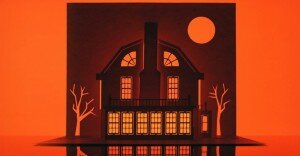Editor (Art)
A piece of A4 paper, a steel ruler and a sharp knife is all you need to re-create the haunting (potentially haunted too) houses of timeless horror cinema culture. That is, of course, if your name’s Marc Hagan-Guirey and you happen to have designed an all time horror anthology of paper buildings.
The iconic hotel from Psycho, the Achilles’ heel of any shower curtain business; the Overlook Hotel from The Shinning, the The Exorcist ’s MacNeill Residence or 112 Ocean Drive from The Amityville Horror. You name it; the ‘Paper Dandy’ designed them all.
Kiragami, the technique used by the artist, is a form of Japanese art mainly based on paper folding; the artist’s task is to cut and fold the paper to create three dimensional rectangular shapes. For the Dakota Building, the house featured in Rosemarie’s Baby, Hagan-Guirey had to cut 400 holes for windows. While doing the final model, the knife slipped at the last hole, so the model had to be re-designed from scratch, Hagan-Guirey told BBC. He went on to add that this type of work calls for incredible patience and composure. You cannot say you have even the most basic knowledge of patience, until you have cut off a 3 inch zombie’s rib cage with a paper knife.
The models are displayed in Perspex light boxes, having, as artist Hagan-Guirey says while talking about the different perspectives viewers have access to, ‘a dual personality’. By day- meticulously crafted works of arts and potentially innocent abodes for respectable families and by night- playground for psychopaths and serial killers. The sinister paper silhouettes almost make you hold your breath in terror, not knowing what they might do next. Yet, thanks to the classic horror culture of the 80s, you actually do know. The darkness lets details lurk in and allows the viewer to go down a rather frightening memory lane straight to the Golden Age of Horror Movies of the 70s and 80s. What you don’t see, can ultimately be even scarier than what you do see. Polanski would know.
Hagan-Guirey enjoyed the project so much to the extent that he quit his job as digital design director to have sufficient time for the grim love child that is horrorgami. Then again, the collection came as a likely follow-up to a lifelong fascination with horror movies:
My parents would go out for the evening and left in the capable hands of my brother, I would beg him to let me stay up with his friends to watch the horror movie they’d rented. Typically he’d have to spend the rest of the night consoling me after said film left me somewhat distraught. He never learned his lesson; nor did I. Thankfully I’ve been left with a fascination of horror and no deeply embedded scars from the trauma they’d caused. At least not that I’m aware of.
After a private viewing of Frank Lloyd Wright’s Ennis house- a veritable spiritual experience- Hagan-Guirey wanted to say thank you to the friend who made it all possible. The house, a genuine architectural jewel, was left in a rather frail condition due to a destructive earthquake as to an ‘unfortunate choice of materials’. So he created a kirigami replica of the property that reflected its frailty.
It didn’t take long until recognition came. Timeout, Attitude, Loaded and then bigger names like io9, ABC and most recently, BBC, published articles about Hagan-Guirey’s delightfully horrific art. However, the vote of confidence that most thrilled the artist came from Laurence Hubbs, the architect who designed the exterior for the 1993 Adams Family mansion.
It all began with a present. And it will all end with a solo gallery displayed at London’s Gallery One and a Half, starting November 1st … or will it?




No comments
Be the first one to leave a comment.